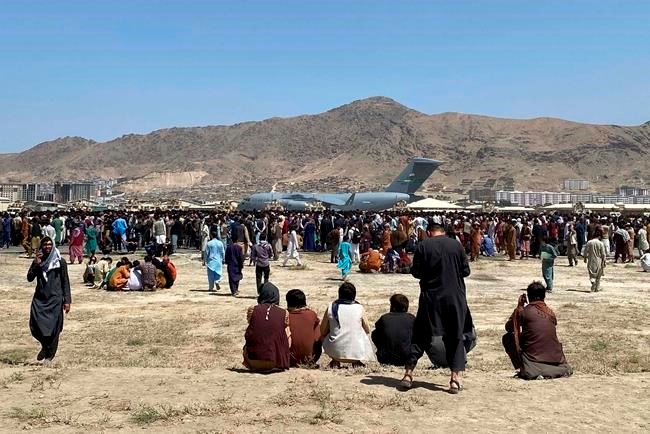OTTAWA — A C-17 Globemaster transport plane evacuated 106 more Afghans from the chaotic Kabul airport on Friday and brought them to a safe third country, Canadian officials said Saturday.
The flight was Canada's second one out of Kabul since Afghanistan fell to the Taliban last weekend, a development that destabilized the country, sowed chaos and exposed numerous Afghans to violent reprisals for their past support of Western-led, anti-Taliban forces, including Canada's.
The impact of that chaos became evident as Canadian officials offered a vivid portrait of the real-life challenges of getting vulnerable Afghans out of harms way as the specter of Taliban reprisals hangs over them.
Desperate Afghans who previously worked as interpreters for Western news agencies and NATO are in hiding, fearing for the safety of themselves and their families. They have been in touch with Canadian news organizations seeking help, including with The Canadian Press.
"Our people are working day and night in a challenging, volatile and dynamic situation. And will we keep doing everything possible to support Afghans in their time of need," said one senior Canadian government official, one of three who briefed journalists Saturday on the condition they not be named as per the agreements for such background briefings.
The Canadian flights are at the mercy of a dangerous and tenuous situation on the ground, but the airlift will continue as long as the security situation holds, officials said.
While the airport has been secured for now, actually reaching it and getting through its perimeter remains extremely dangerous, officials said.
That has contributed to a frenzied dynamic on the ground that faces another obstacle: the massive Canadian planes don't have the ability to refuel in air, so they have to take off with fewer passengers because of the heavy gas tanks they need to make their return flight to safety.
The C-17s are on the ground for only a short period of time, officials said, and their engines are kept running, as passengers scramble into the plane's massive belly from the rear entry ramp. Seatbelts appear to be a luxury.
In a "very dynamic situation," young pilots and aircraft managers are assessing the risks, so if "they (passengers) are sitting on the floor, they're fine with that," said one official.
They said foreign nationals were also on the Friday flight, but did not disclose the number citing security reasons.
Friday's flight followed a Thursday Canadian airlift bearing 175 fleeing Afghans and 13 foreign nationals.
All of the Afghans were interpreters and other workers who supported Canada's military and diplomatic efforts in the war-torn country.
The Afghans on Thursday's flight are bound for other countries, while the 106 on Friday's are destined for settlement in Canada, officials explained, noting the effort comes as part of Canada's commitment to resettle 20,000 refugees.
Immigration officials are working remotely from Ottawa and throughout the Middle East to process applications for Afghans trying to flee to Canada.
Global Affairs Canada personnel are in direct contact with applicants in Kabul via email and cellphone to gather information for their applications and tell them when they can try to make their way to the airport.
So far, almost 1,000 endangered Afghans have reached Canada. Immigration officials are processing about 3,000 of the 6,000 claims from endangered Afghans seeking too flee, officials said.
Officials acknowledged that some Afghans destined for the Friday flight couldn't get to the airport, but their advice was to keep trying and they will be put on a plane if they succeed, .
This report by The Canadian Press was first published Aug. 21, 2021.
Mike Blanchfield, The Canadian Press



